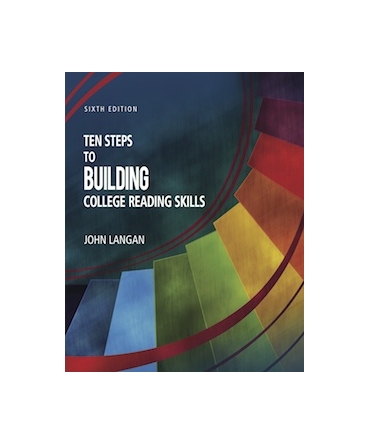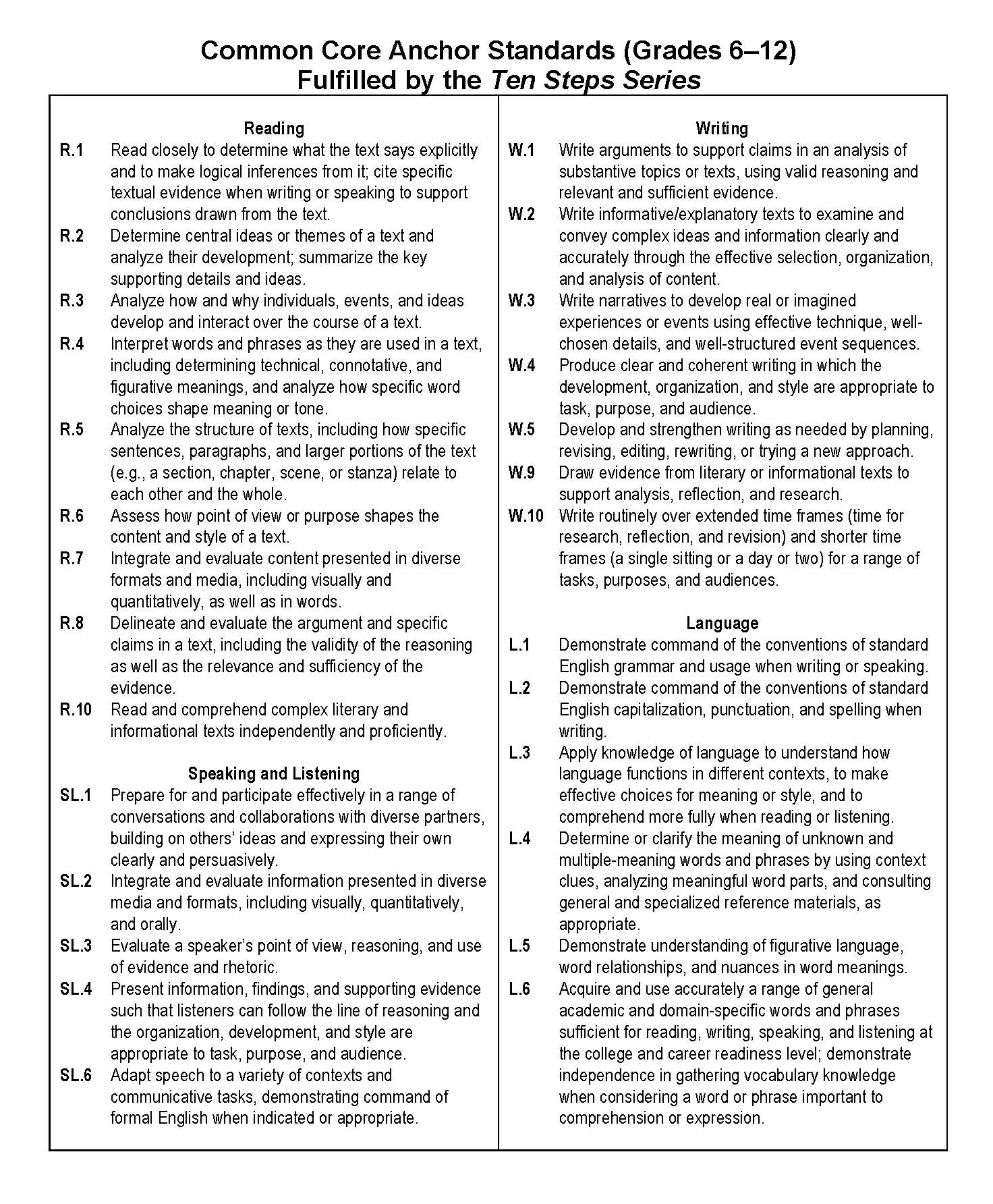Ten Steps to Building College Reading Skills, 6/e

Overview
Ten Steps to Building College Reading Skills covers ten basic reading skills essential for sound reading comprehension. This new edition in the Ten Steps series is suitable for the basic developmental reading course offered at most colleges AND for high school English/Language Arts classes focused on building college readiness.
More information
Educators, please click here to request a desk copy.
Key Features of the Ten Steps Series
Focus on the basics. The book is designed to explain, in a clear, step-by-step way, the essential elements of each skill. Many examples are provided to ensure that students understand each point. In general, the focus is on teaching the skills—not just on explaining them and not just on testing them.
Frequent practice and feedback. Because abundant practice and careful feedback are essential to learning, this book includes numerous activities. Students can get immediate feedback on the practice exercises in Part One by turning to the limited answer key at the back of the book. The answers to the review and mastery tests in Part One, the reading questions in Part Two, and the relationships and combined-skills tests in Part Three are in the Instructor’s Edition and the Instructor's Manual.
High interest level. Dull and unvaried readings and exercises work against learning. Students need to experience genuine interest and enjoyment in what they read. Teachers as well should be able to take pleasure in the selections, for their own good feeling about them can carry over favorably into class work. The readings in the book, then, have been chosen not only for the appropriateness of their reading level but also for their compelling content. They should engage students and teachers alike.
Ease of use. The logical sequence in each chapter—from explanation to example to practice to review tests to mastery tests—helps make the skills easy to teach. The book’s organization into distinct parts also makes for ease of use. Within a single class, for instance, instructors can work on a particular skill in Part One, review another skill with one or more mastery tests, and provide variety by having students read one of the selections in Part Two. The limited answer key at the back of the book also makes for versatility: the teacher can assign parts of some chapters for self-teaching. Finally, the mastery tests—each on its own tear-out page—and the combined-skills tests make it a simple matter for a teacher to test and evaluate student progress.
Integration of skills. Students do more than learn the skills individually in Part One. They also learn to apply the skills together through the reading selections in Parts One and Two as well as the combined-skills tests in Part Three. They become effective readers and thinkers through repeated practice in applying a combination of skills.
Thinking activities. Thinking activities—in the form of outlining, mapping, and summarizing—are a distinctive feature of the book. In addition, four discussion questions at the end of each reading selection encourage student reflection, as do the writing activities that are provided for each selection.
Available electronic resources. This text can be purchased with Ten Steps Plus, a subscription-based collection of digital materials including interactive exercises, mastery tests, assessments, bonus readings, instructional videos, eBooks* of the entire Ten Steps Series, and more than 100 Townsend Library titles. Click here to learn more about subscription options, including discounted digital/textbook bundles.
*eBooks are not included with Ten Steps Plus LE (Limited Edition).
Efficacy Report. Results from a study that examined the impact of the Townsend Press Ten Steps Series on students' reading skills in higher education developmental reading courses are available (full report, short report). This study was conducted by an independent research firm.
Changes in the Sixth Edition
• Enhanced Visuals. Because so many students today are visual learners, numerous cartoons and other graphics have been added to help introduce or illustrate points made in the book.
• Clarity and Friendliness. Exceptional clarity has always been a hallmark of John Langan’s books—in the step-by-step explanations for each skill, in the logically sequenced materials, and even in the care given to the questions and answer choices in the activities. Countless numbers of teachers have praised the friendly and helpful tone of John Langan’s books—a tone that never condescends to students. This revised book is no exception. In addition, the human content of the paragraphs and longer selections will definitely appeal to you and your students.
• Fresh Materials. The book includes six new high-interest readings, a set of eight relationships tests, added combined skill tests, an expanded offer for free book, and a freshening of illustrations and practice materials throughout.
• Ten Steps Plus. This is a powerful subscription-based suite of digital resources for your college reading or college readiness program. Ten Steps Plus includes the following: exercises, mastery tests, assessments, and instructional videos; a Skills Bank; a Readings Bank; and eBooks* of the entire Ten Steps Series and more than 100 Townsend Library titles. Note: Students must have a paid subscription to access Ten Steps Plus materials. Click here to learn more about subscription options, including discounted digital/textbook bundles.
* eBooks are not included with Ten Steps Plus LE (Limited Edition).
Preface: To the Instructor
INTRODUCTION
1 Getting Off to a Strong Start
2 One Reader's Story
3 How to Become a Better Reader and Thinker
PART ONE
Ten Steps to Building College Reading Skills
1 Dictionary Use
Reading: Responsiblity M. Scott Peck
Mastery Tests
2 Vocabulary in Context
Reading: All the Good Things Sister Helen P. Mrolsa
Mastery Tests
3 Main Ideas
Reading: Group Pressure Rodney Stark
Mastery Tests
4 Supporting Details
Reading: A Door Swings Open Roxanne Black
Mastery Tests
5 Locations of Main Ideas
Reading: Body Language Beth Johnson
Mastery Tests
6 Relationships I
Reading: Behind Closed Doors: Violence in the Family Michael S. Bassis, Richard J. Gelles, and Ann Levine
Mastery Tests
7 Relationships II
Reading: Conversing in Real Life Sarah Rice
Mastery Tests
8 Inferences
Reading: A Path to Marriage Jean Sutton
Mastery Tests
9 Implied Main Ideas
Reading: Lighting a Match Regina Ruiz
Mastery Tests
10 The Basics of Argument
Reading: Do it Better! Ben Carson, M. D., with Cecil Murphey
Mastery Tests
PART TWO
Ten Reading Selections
1 Winners, Losers, or Just Kids Dan Wightman
2 The Right Words at the Right Time Jeff Bezos
3 Eye Contact Ron Clark
4 Judge Judy Speaks Judge Judy Sheindlin
5 Read All About It Fran Deblasio
6 Erika Hilario Beth Johnson
7 How to Make It in College, Now That You're Here Brian O'Keeney
8 Cooling Down Our Brains Jason Peters
9 Dealing with Feelings Rudolph F. Verdebrer
10 Not So Sweet Alessa Staley
PART THREE
Active Reading, Relationships and Combined-Skills Tests
1. An Introduction to Active Reading
2. Practice in Active Reading I: Relationships Tests
3. Practice in Active Reading II: Combined-Skills Tests
Appendixes
Separating Fact from Opinion
Identifying an Author's Purpose and Tone
Writing Assignments
Limited Answer Key
The Ten Steps Reading Series and the Common Core State Standards
Looking for a powerful, effective, Common Core-aligned resource to help you teach reading to your students? With the Ten Steps Series, you’ve got it.
For more than two decades, the Ten Steps Series has helped millions of students learn the reading skills needed for success in the classroom and beyond. Developed to prepare college students for the rigors of college-level reading courses, the Ten Steps Series addresses the competencies and benchmarks outlined in the Common Core State Standards (CCSS) for grades 6–12.
The connection between the Common Core and the Ten Steps Series emerges from their shared educational fundamentals. Both draw from practical classroom experience and research in the field of reading. Both focus on the same goal: to empower students to be strong, active, and critical readers. And both, in an effort to achieve this goal, outline a series of foundational skills students need to master. The Ten Steps Series goes one step further; it teaches these skills with a range of print-based and online practice exercises, assignments, readings, and mastery tests . The result has been a hugely successful series of books that have helped millions of college students transition from developmental reading courses into the advanced classes they need for degrees. This same trajectory of success is available now to middle and high school students.
Every one of the six books in the Ten Steps Series covers the CCSS Anchor Standards for Grades 6–12 itemized below, in the following categories: Reading, Writing, Speaking & Listening, and Language.
In addition, all of the books in the Ten Steps Series also fulfill key CCSS benchmarks for the specific grade levels they span. The downloadable Ten Steps Series CCSS Grade-Level Analysis lists the specific CCSS benchmarks, by grade, covered in each of the Ten Steps books.

[1] CCSS Anchor Standards citations are coded as follows: The abbreviation of the instructional strand’s name and then the standard number. So the standard labeled “R.3” indicates the “Reading” strand, standard number three, which is “Analyze how and why individuals, events, and ideas develop and interact over the course of a text.” For a complete listing of the CCSS, please visit www.corestandards.org.
Supplementary Materials
Print Supplement
Like all Ten Steps texts, this edition features an annotated Instructor’s Edition, which is identical to the student book except that it provides answers to all the practices and tests. In addition, the Instructor's Edition includes useful hints for teachers as well instructive annotation to help scaffold lessons. No other book on the market has such detailed and helpful annotations.
Digital Supplements
1. A downloadable Instructor’s Manual and Test Bank includes suggestions for teaching, a model syllabus, and readability levels for the text and the reading selections. The test bank contains four additional mastery tests for each of the skills chapters in Part I—all on letter-sized sheets so they can be copied easily for use with students. This resource is available to all instructors in the Learning Center.
2. Downloadable PowerPoint presentations have been crafted to teach key skills and concepts directly to students. These PowerPoints are available free to instructors in the Learning Center.
3. Ten Steps Plus is a powerful subscription-based collection of digital resources for your college reading or college readiness program. Based on the acclaimed pedagogy of the Ten Steps Series, Ten Steps Plus is a digital suite of exercises, mastery tests, assessments, and instructional videos; a Skills Bank; a Readings Bank; and eBooks* of the entire Ten Steps Series and more than 100 Townsend Library titles. Note: Students must have a paid subscription to access Ten Steps Plus materials. Click here to learn more about subscription options, including discounted digital/textbook bundles.
* eBooks are not included with Ten Steps Plus LE (Limited Edition).
To Obtain Supplements
Print supplements can be obtained quickly by calling Townsend Press (1-800-772-6410), by sending a fax on school letterhead to 1-800-225-8894, or by e-mailing Customer Service at cs@townsendpress.com. Digital supplements are free to educators with a valid instructor account in the Learning Center. Get yours here.
